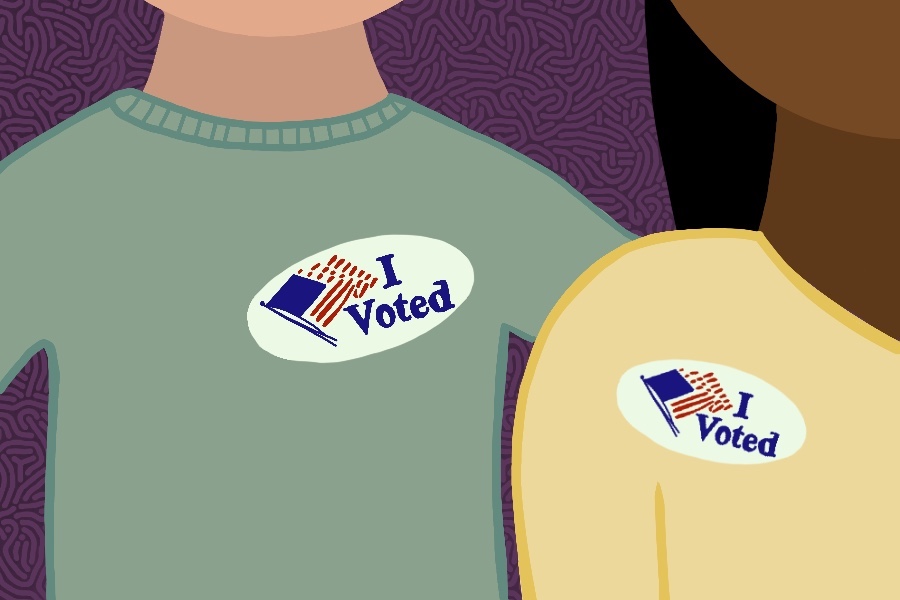Big Ten election panel discusses voter registration and potential election outcomes
With the collaboration of Connections for the Homeless and the Democratic Party of Evanston, Kemone Hendricks is helping people experiencing homelessness register to vote.
October 28, 2020
With one week left before Election Day, scholars spoke at a Big Ten college collaboration webinar to provide a research-based approach to interpreting the 2020 presidential election.
The panel, which was co-sponsored by NU Votes and moderated by SESP Prof. Dan Lewis, discussed factors that affect voter turnout in the U.S. and on college campuses specifically.
Michael Traugott, political studies prof. at the University of Michigan, began by breaking down the division of partisanship in America by demographic. He spoke of how partisanship varies with race, with White Americans slightly favoring Republicans and minorities strongly preferring Democrats.
Additionally, Traugott presented statistics showing that former Vice President Joe Biden has a considerable lead over President Donald Trump from those submitting mail-in ballots and those who vote early. But he said Trump is projected to have a two-to-one lead on Biden for in-person voters on Election Day.
“The shadow of COVID hanging over the entire campaign… has increased the willingness or the propensity of people to vote by mail or by absentee ballot,” Traugott said.
By some estimates, Traugott inferred that turnout in this election could be 10 percentage points higher than in the 2016 election. In addition, he indicated that Biden’s 9.1 percentage point lead against Trump in the national polls was significant. But the outcome could become closer due to Trump’s campaigning strategies, he said, such as Trump’s advantage in the number of field offices in swing states and Republican efforts in canvassing.
Dave Brinker, a researcher at the Institute for Democracy and Higher Education at Tufts University, focused his presentation on college student turnout rates.
Brinker based his conclusions on the research by the National Study of Learning, Voting and Engagement for college campuses. He compared the effectiveness of registering new voters versus getting them to vote and concluded that turnout, or yield rate, of registered voters was more impactful to overall voting rate than voter registration.
“In every state and every context, you can find your registered friends and ask if they are really going to vote and if they need help voting,” Brinker said. “Every unit of effort you were to put into yield rate would result in more student voters than every unit of effort you would put into registration rate.”
Brinker also explored the possible reasons why college students would be voting or not voting in the upcoming election. He cited increasing polarization, strong sentiments about Trump and increasing student activism as factors propelling student voters. But he said practical issues such as proximity of polling locations and availability of early voting options could deter students from casting their ballots.
Diana Mutz, political science and communication prof. at the University of Pennsylvania, focused her presentation on statistics from a panel study that compared the same citizens from 2016 and 2020. She said the study focused on two core themes: whether people shifted their political preferences, and whether the upcoming voter turnout could change.
Mutz’s statistics showed turnout will be higher this year, especially among those who did not vote in the 2016 election, and more previous voters are changing their minds on the political party they choose to support.
“Based on what I’ve seen here, it appears that Biden is winning over more previous Trump voters than Trump is winning Clinton voters,” she said.
Mutz also found that many third party voters from 2016 are choosing not to do the same this year, instead opting to choose one of the two main party candidates. However, she doesn’t believe the projected higher turnout will “necessarily advantage one candidate over another” based on the data collected by the study.
Students in Mutz’s class were disappointed with both major candidates running for office, she said, possibly because they were not relatable to young voters due to their age and race — which reduced excitement for the election.
“What I hope everyone young and old does realize is that their vote is extremely important this year,” Mutz said. “Don’t waste your opportunity to vote or for whom you vote.”
Email: [email protected]
Twitter: @hankyang22
Related Stories:
— 2020 election panel talks Biden candidacy, polling at CTSS event
— NU stresses voting and civic engagement ahead of November election












